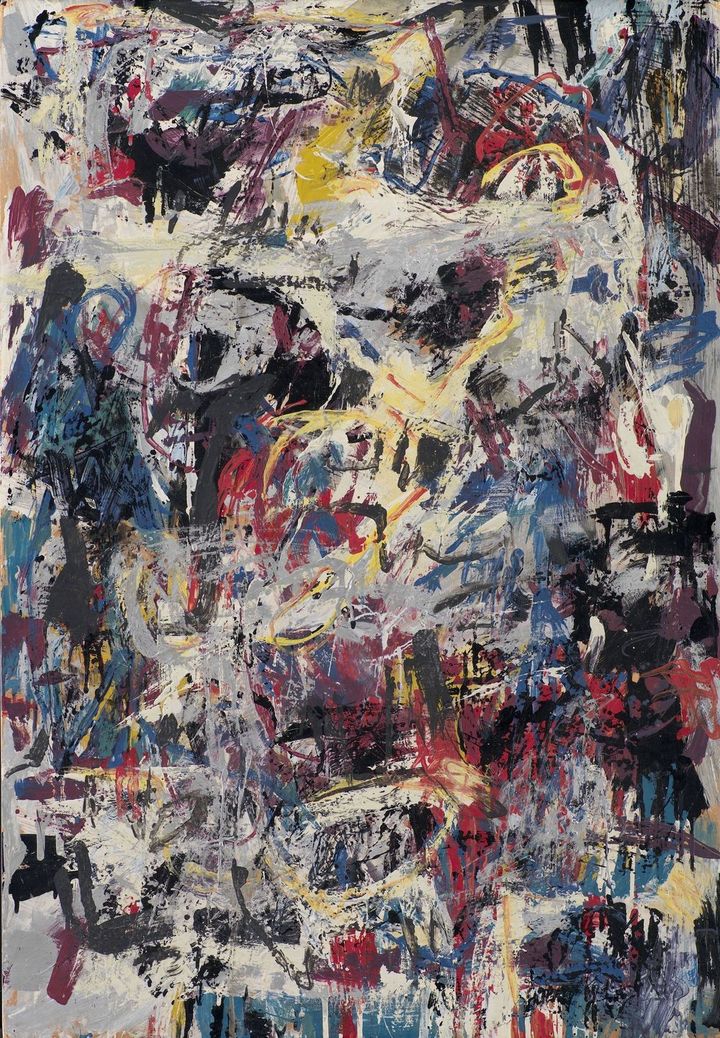Arthur Køpckes Arkiv
Introduction

Arthur Köpcke: Hommage à Malevich, 1960.
Oil on cardboard, 100 x 70 cm.
Statens Museum for Kunst. © Arthur Köpcke / VISDA
Arthur Køpcke – who also wrote his name as Köpcke, Koepcke or Køpke – is recognized as a highly esteemed artist today. The gallery that he ran from 1958 to 1963 together with his wife, Tut, is also highly acclaimed, both in Denmark and around the world. In both cases, the main focus of attention is his involvement in and contributions to neorealism and Fluxus. His early period in Denmark, from 1958 to around mid 1960, when his key focus was on informal art, has not been the subject of a similar degree of interest, whether in Køpcke’s own work as an artist or in the exhibitions at the gallery.
The Arthur Køpcke Archive at the ARoS art museum in Aarhus, which has now been digitized, sheds light on precisely this early period. The archive contains over 620 documents, mainly letters but also other categories, such as invitation cards, scrapbooks, transport documents and so forth. Together, the documents provide insight into Køpcke’s contact with artists and gallery owners abroad as well as the day-to-day management of the gallery. Notably, one category of information is largely absent from the archive (a significant omission from posterity’s point of view): information about sales and accounts.
From the outset, the gallery had an international outlook. Køpcke, who was German, had settled in Denmark in 1958. At the time, he may not have known much about Danish art or the local art scene. Perhaps he was not interested, as he was able to reach out to artists in Paris through one of his close friends from Hamburg, the painter Egon-Karl Nicolaus. By 1958, Nicolaus was living in Meudon near Paris, which at the time had a bustling international art scene. The two men arranged for Nicolaus to act as an agent for Køpcke in Paris, including contacting artists and inviting them to exhibit in Køpcke’s Copenhagen gallery. Thus, most of the artists who exhibited at the gallery initially were artists who had worked in Paris for a shorter or longer period of time.
Over time, the situation changed, as Køpcke came into contact with other artists, who either had or were establishing a European network. One of these artists was Henk Peeters, a member of the Dutch informal art group that exhibited at Køpcke’s gallery in January 1960, and a deft organizer. He advocated for Køpcke on his travels around Europe and gave Køpcke suggestions for promising galleries to contact. Later, Peeters was one of the co-founders of the NUL group, a parallel to the German Zero movement, and helped bring the two groups together in large exhibitions. In Denmark, Gunnar Aagaard Andersen played an important role thanks to his international contacts, which he often introduced to Køpcke.
Before he came to Denmark, Køpcke had held a variety of jobs, but he does not appear to have had any art gallery experience. Tut, who had worked ‘for the English’ in Hamburg (it is unclear what the work entailed), also had no experience from the art world. Given this lack of prior experience, they displayed a remarkable degree of professionalism in establishing their gallery. Even if the location may not have been ideal – a courtyard in Læderstræde in Copenhagen that had previously housed a herring smokehouse – the invitation cards, visitors’ book and press clippings (which they received through a subscription service and pasted into scrapbooks) suggest that they had a fairly good idea of what it took. However, they struggled to make a living from the gallery. As mentioned earlier, the archive contains no financial information, but several of the letters seem to make clear that they struggled to make ends meet.
These challenges notwithstanding, in March 1960, they were able to move out of the humble space in Læderstræde and into a better space in Lille Kirkestræde 1, also in central Copenhagen. This new venue became the setting for most of the experimental exhibitions, which ultimately earned Køpcke an international reputation due to the calibre of artists involved. Gunnar Aagaard Andersen later wrote about the gallery: ‘As a painter, one was immediately welcome here, which is far from true of all galleries. This was no business, and it never became one. It was something that is also important; it was a gallery dedicated to the important elements of contemporary art that by virtue of their very nature must remain outside the domain of business.’ Indeed, as early as the summer of 1962, the gallery had to close. Knud Pedersen, who had rented the nearby former Nikolaj Church for his art library, invited Køpcke to stage exhibitions at the church (just as he also made the church space available for Fluxus concerts in November 1962), but ultimately, Køpcke held just two exhibitions there. This marked the end of Køpcke and Tut’s gallery endeavour.
Anneli Fuchs